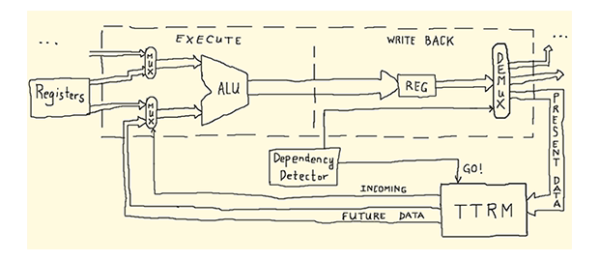Not all of the entries to The Hackaday Prize were serious – at least we hope not – and this one is the most entertaining of the bunch. [Eduardo] wants to put a flux capacitor in a CPU pipeline. Read that last sentence again, grab a cup of coffee, mull it over, and come back. This post will still be here.
Assuming the events portrayed in BTTF could be real in some alternate history or universe, consider the properties of a DeLorean time machine: It requires 1.21 Jiggawatts (we’re assuming this is Gigawatts from now on), has a curb weight of about three thousand pounds with the nuclear reactor and/or hovercar conversion, and is able to travel in time ± 30 years. If the power required to travel time were to scale proportionally with mass, sending a CPU register back in time would only require a Watt or so. Yes, ‘ol [Doc Brown] had it wrong with wanting to send a car back in time – sending information back is much, much easier. Now, what do you do with it?
[Eduardo] is using this to speed up pipelined CPUs. In a CPU pipeline, instructions are executed in parallel, but if one instruction depends on the output of another instruction, bad things happen CPU designers have spent long, sleepless nights figuring out how to prevent this. Basically, a MEMS flux capacitor solves all outstanding problems in CPU design. It’s brilliant, crazy, and we’re glad to see it as an entry to The Hackaday Prize.
[Eduardo], though, isn’t seeing the forest for the trees. If you have a flux capacitor in your CPU, why even bother with optimizing a CPU? Just take a normal CPU, add a flux capacitor register, and have the output of a long and complex calculation write to the time traveling register. All calculations then happen instantly, your Ps and NPs are indistinguishable. All algorithms run in O(1), and the entire endeavor is a light-hearted romp for the entire family.
 This project is an official entry to The Hackaday Prize that sadly didn’t make the quarterfinal selection. It’s still a great project, and worthy of a Hackaday post on its own.
This project is an official entry to The Hackaday Prize that sadly didn’t make the quarterfinal selection. It’s still a great project, and worthy of a Hackaday post on its own.












